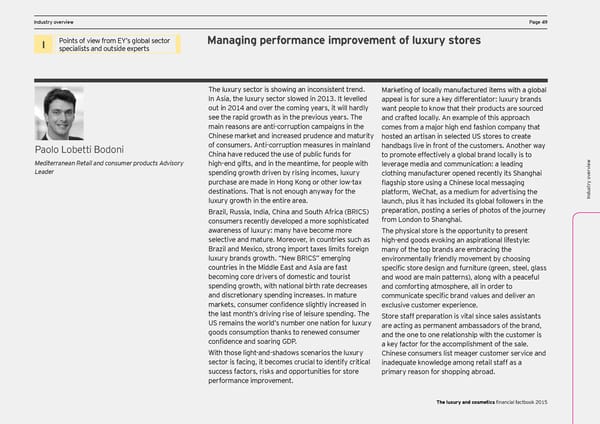DCF and vIndustry oaluation pverview arameters PPage 49age 49 I Points of view from EY’s global sector Managing performance improvement of luxury stores specialists and outside experts The luxury sector is showing an inconsistent trend. Marketing of locally manufactured items with a global In Asia, the luxury sector slowed in 2013. It levelled appeal is for sure a key differentiator: luxury brands out in 2014 and over the coming years, it will hardly want people to know that their products are sourced see the rapid growth as in the previous years. The and crafted locally. An example of this approach main reasons are anti-corruption campaigns in the comes from a major high end fashion company that Chinese market and increased prudence and maturity hosted an artisan in selected US stores to create Paolo Lobetti Bodoni of consumers. Anti-corruption measures in mainland handbags live in front of the customers. Another way China have reduced the use of public funds for to promote effectively a global brand locally is to Mediterranean Retail and consumer products Advisory high-end gifts, and in the meantime, for people with leverage media and communication: a leading w Leader spending growth driven by rising incomes, luxury clothing manufacturer opened recently its Shanghai ervie v purchase are made in Hong Kong or other low-tax flagship store using a Chinese local messaging try o destinations. That is not enough anyway for the platform, WeChat, as a medium for advertising the Indus luxury growth in the entire area. launch, plus it has included its global followers in the Brazil, Russia, India, China and South Africa (BRICS) preparation, posting a series of photos of the journey consumers recently developed a more sophisticated from London to Shanghai. awareness of luxury: many have become more The physical store is the opportunity to present selective and mature. Moreover, in countries such as high-end goods evoking an aspirational lifestyle: Brazil and Mexico, strong import taxes limits foreign many of the top brands are embracing the luxury brands growth. “New BRICS” emerging environmentally friendly movement by choosing countries in the Middle East and Asia are fast specific store design and furniture (green, steel, glass becoming core drivers of domestic and tourist and wood are main patterns), along with a peaceful spending growth, with national birth rate decreases and comforting atmosphere, all in order to and discretionary spending increases. In mature communicate specific brand values and deliver an markets, consumer confidence slightly increased in exclusive customer experience. the last month’s driving rise of leisure spending. The Store staff preparation is vital since sales assistants US remains the world’s number one nation for luxury are acting as permanent ambassadors of the brand, goods consumption thanks to renewed consumer and the one to one relationship with the customer is confidence and soaring GDP. a key factor for the accomplishment of the sale. With those light-and-shadows scenarios the luxury Chinese consumers list meager customer service and sector is facing, it becomes crucial to identify critical inadequate knowledge among retail staff as a success factors, risks and opportunities for store primary reason for shopping abroad. performance improvement. The luxury and cosmetics financial factbook 2015
 Seeking sustainable growth - The luxury and cosmetics financial factbook Page 50 Page 52
Seeking sustainable growth - The luxury and cosmetics financial factbook Page 50 Page 52